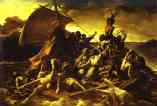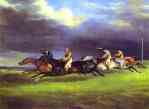Jean Louis André Théodore Géricault Biography
Théodore Géricault was born into a wealthy Rouen family in 1791. He studied with the painters Carle Vernet (1758-1836) and Pierre Guérin (1774-1833) in Paris, and in 1816-1818 traveled to Italy. The Old Masters, especially Michelangelo and Rubens, influenced him more than any contemporary artist. Already in his early works Géricault strays away from the Neoclassical canons, which dominated in the French art of the time. His ‘mounted officers’ of 1812, Musée du Louvre, Paris and of 1814, Musée du Louvre ‘display violent action, bold design, and dramatic colour, and evoke powerful emotion,’ the traits characteristic of the newly born Romanticism.
On his return to Paris, Géricault exhibited The Raft of the Medusa at the 1819 Salon. Although it received the gold medal, it also caused a political scandal because of its subject. The shipwreck of the frigate Medusa took place in June 1816 near the West African coast. The crew left 150 passengers to their fate on a raft. When, two weeks later, the raft was found, there were only 15 survivors, 5 of them died after rescue. The case was silenced by the government, and when, a year later, it became public knowledge, it caused rage and criticism of governmental negligence and corruption. To achieve accuracy, the painter used a model of the raft and carefully studied real corpses. In this huge canvas, about 5 x 7 meters, Géricault mixed Realism and Romanticism. The combination of idealized figures and realistically depicted agony, absence of ‘classical’ or ‘heroic’, gigantic size and graphic detail, aroused violent debates between Neoclassical and Romantic artists. The painting had a seminal influence on the further development of Romanticism.
Between 1820-22 Géricault visited England, during which time he painted jockeys and racecourses, e.g. The Derby at Epson in 1821; and made lithographs showing the misery and poverty widespread on the streets of London.
In 1822-23 he painted ten portraits of patients at La Salpetrière, the madhouse in Paris. Théodore Géricault died tragically early after falling from a horse.
Bibliography
French Drawings from the 15th Century Through Géricault by Jean Vallery-Radot. Little Brown & Co (Pap), 1976.
Géricault: His Life and Work by L. Eitner. Hacker Art Books, 1982.
The Raft of the Medusa: Gericault, Art, and Race by Albert Alhadeff. Prestel Publishing, 2002.
Gericault in Italy by Wheelock Whitney. Yale University Press, 1997.
Géricault by Jean Sagne. Fayard, 1991.
- The Raft Of The "Medusa".

1818-1819. Oil on canvas. 490 x 720 cm. Louvre, Paris, France.
- The Derby At Epson.

1821. Oil on canvas. 92 x 123 cm. Louvre, Paris, France.